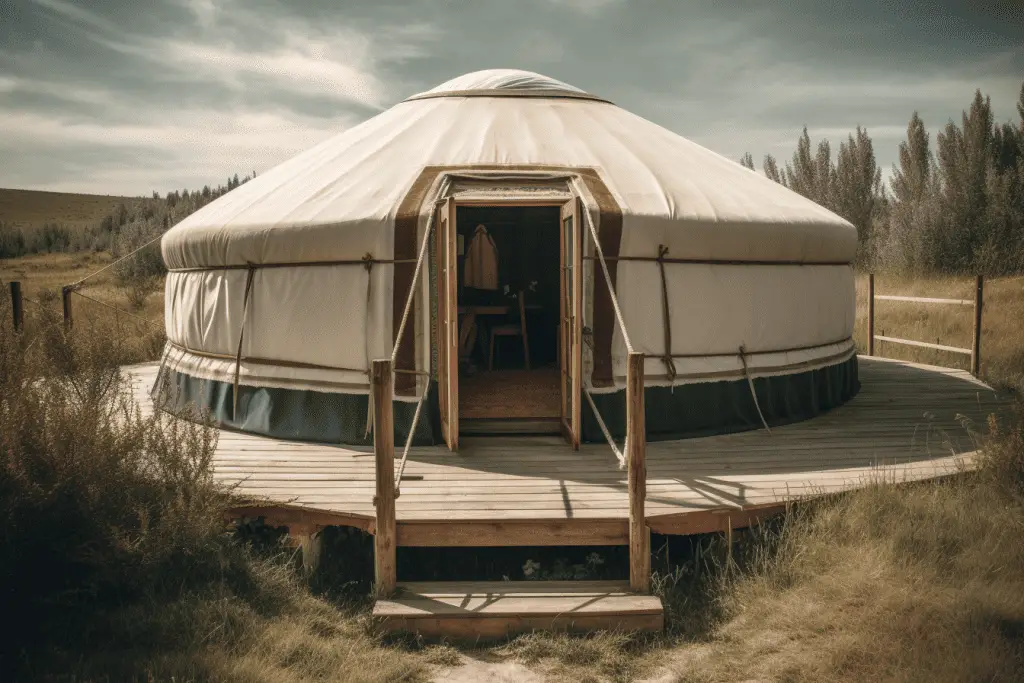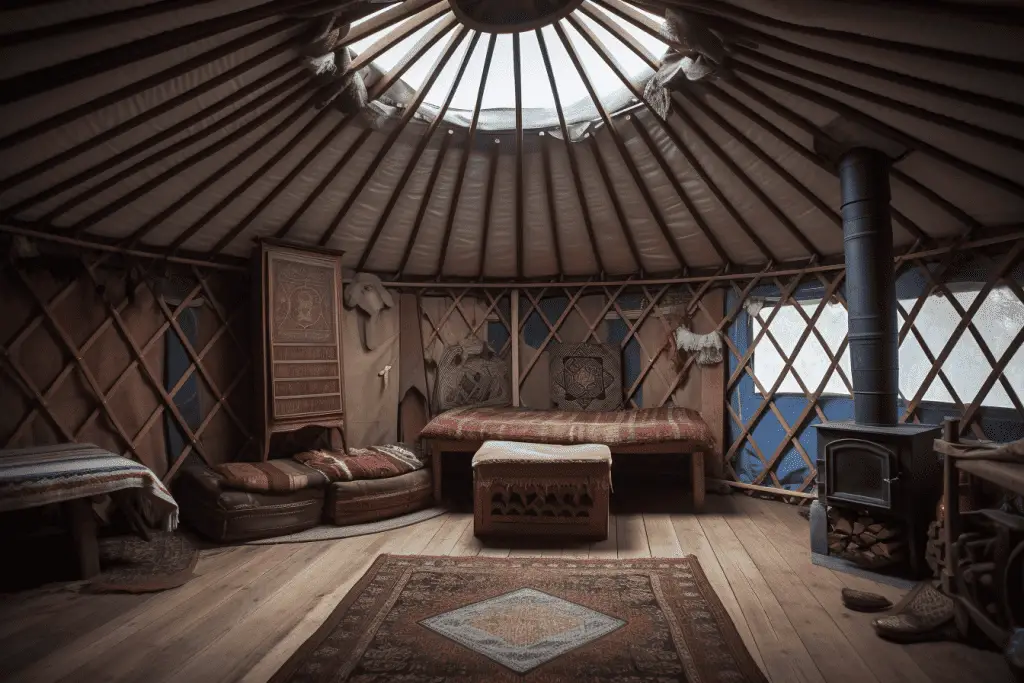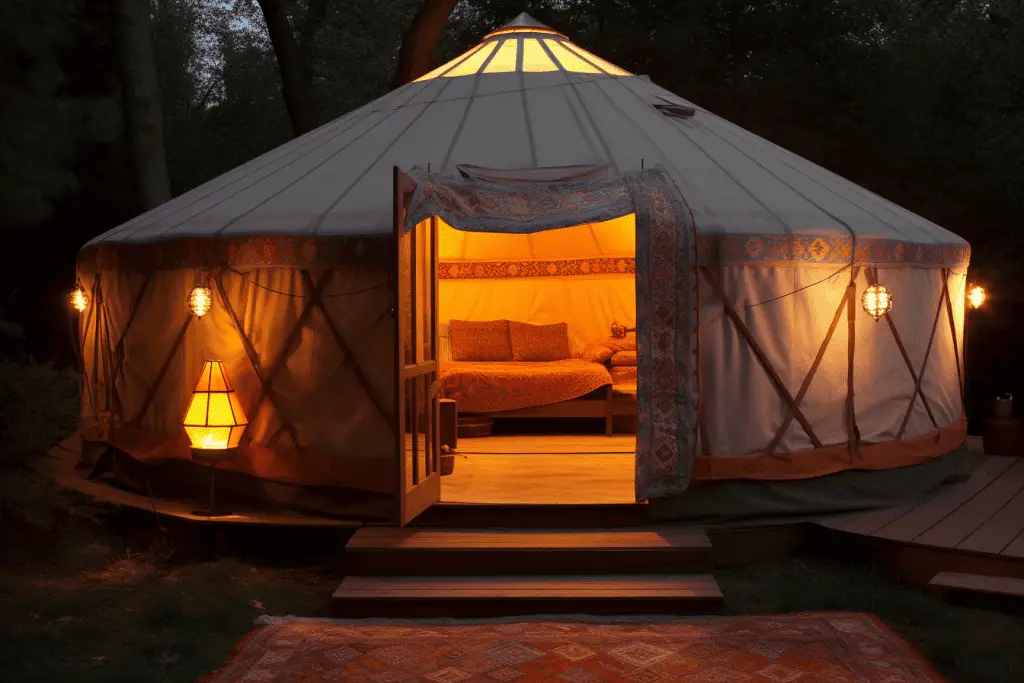In keeping with our series on tents, we’ll answer the question what is a yurt tent?
A yurt tent is a portable, round-shaped structure that originated in Central Asia. It is traditionally made of a lattice wall and a fabric cover, providing a comfortable and spacious living space. Yurt tents are popular for camping and glamping, offering a unique and cozy experience in nature.

The Modern Use of Yurt Tents: From Camping to Glamping
The modern use of yurt tents is really something else. They’ve truly evolved from their nomadic origins and entered a whole new realm – from basic camping to luxury glamping!
Nowadays, yurt tents are popular among camping enthusiasts who love the feel of being close to nature, yet appreciate some comforts of home. You see, yurts have this unique ability to combine the rustic charm of outdoor living with modern conveniences. They’re spacious enough to fit beds, furniture, even a small kitchen area. It’s not just about sleeping bags and campfires anymore – it’s about experiencing the great outdoors without sacrificing comfort.
But, it’s not just about camping. Have you ever heard of ‘glamping’? It’s glamorous camping, and yurt tents fit this trend perfectly. Many glamping sites offer fully furnished yurts with amenities you wouldn’t normally expect in a tent – think cozy beds, electricity, heating, and sometimes even private bathrooms. It’s a fantastic option for those who want to experience nature without giving up the luxury of modern living.

Yurts are also popping up in all sorts of non-camping contexts. They’re being used as Airbnb rentals, yoga studios, meditation spaces, classrooms, and even home offices. Their appeal goes beyond their functionality; they also offer a unique, aesthetically pleasing environment that’s quite different from your typical four-walled room.
So whether you’re a hardcore camper, a glamping enthusiast, or just someone looking for an alternative living or working space, yurt tents offer a fascinating blend of tradition and modernity. From their humble origins on the steppes of Central Asia, yurt tents have come a long way, adapting to our modern needs while keeping their distinctive charm intact.
What Makes Yurt Tents Unique: Distinctive Features
One of the coolest things about yurt tents is how unique they are. They’re not your typical camping tent, and that’s what makes them so appealing.
First off, let’s talk about the structure. The circular design itself is a standout. It’s not just for aesthetics, it actually distributes weather elements like wind evenly across the structure. So, instead of getting knocked around like a typical tent, a yurt tent stands strong.
Then there’s the lattice framework – imagine crisscrossed wooden or bamboo sticks that form the walls. It’s lightweight yet incredibly sturdy, which means you can have a spacious interior without lugging around a heavy tent. And right at the top, there’s the crown, or toono. This nifty feature is not only a skylight but also a chimney! It can be opened or closed, providing both ventilation and light.
Yurt tents also offer a sense of community. Their open, circular floor plan makes it easy for everyone to interact. You’re not compartmentalized in separate rooms or corners. It’s about being together, sharing stories, food, and warmth.
Other Uses of Yurt Tents: Uses and Functions
Yurt tents have this great reputation for being incredibly versatile and for good reason. Sure, we associate tents with camping, and yurts are absolutely fantastic for that. Imagine having the space to comfortably stand, move around, and even fit your whole family or group of friends in one circular space. They’re like the SUVs of camping tents – roomy, durable, and ready for an adventure.
But you know what? That’s just the tip of the iceberg. Yurts are not just weekend camping trip material, they can be used for long-term stays too. In fact, in many parts of the world, yurts serve as homes. They’re easy to build and take down, making them a practical choice for nomadic lifestyles. Some people even use them as guest houses, artist studios, or home offices. How cool is that?

And it doesn’t stop there. Ever heard of yurt yoga studios or meditation spaces? Well, they’re a thing! The round shape and natural light filtering from the crown create a serene environment, perfect for finding your zen.
Lastly, let’s talk about eco-tourism. Many resorts and vacation spots have adopted yurt tents as sustainable accommodation options. They offer a unique, close-to-nature experience that modern hotel rooms often lack.
So, when we say yurt tents are practical, we really mean it. Whether it’s camping, living, working, or just relaxing, these versatile structures have got you covered – literally!
The Pros and Cons of Camping In a Yurt
Let’s dive into the pros and cons of camping in a yurt, because, as much as we love them, they might not be the perfect fit for every camper out there.
Here’s a table summarizing the pros and cons of camping in a yurt:
| Pros | Cons |
|---|---|
| Spacious interior, allowing for a more comfortable camping experience | Bulkier and heavier than a traditional tent, making it harder to transport |
| Durable and stable in various weather conditions | More complex and time-consuming to set up |
| Skylight for natural light during the day and stargazing at night | Open floor plan may limit personal privacy |
| Unique and memorable camping experience | Might not be suitable for backpacking due to its size and weight |
| Can be furnished with home-like amenities | Requires multiple people for assembly |
Advantages of Camping In a Yurt
Starting with the positives, yurts are incredibly spacious. Compared to a regular dome tent, you’re looking at a significant upgrade in terms of roominess. You can stand up, move around, even arrange furniture or beds, which can make your camping experience more comfortable.
Next, yurts are durable and stable. Their circular structure and strong framework are designed to withstand harsh weather conditions. Rain or shine, a yurt provides a reliable shelter. Plus, the design typically includes a skylight at the top, which means natural light during the day and stargazing opportunities at night. How cool is that?
Yurts also provide a unique camping experience. Their distinctive charm and comfort level can turn a simple camping trip into a memorable adventure. It’s not every day you get to sleep in a structure with such rich history and unique design.
Disadvantages of Camping In a Yurt
Now, let’s talk about the other side of the coin. One potential downside is that yurts can be quite heavy and bulky to transport. If you’re used to backpacking with a lightweight tent, a yurt might not be the best option.
Setting up a yurt can also be more complex and time-consuming than a traditional tent. It’s not rocket science, but you’ll need to allow for some extra time and probably a few extra hands.
Lastly, privacy can be a bit limited in a yurt. The open floor plan that’s great for group interaction doesn’t provide much seclusion. If you’re camping with others and need some personal space, this might be a factor to consider.
So there you have it. Yurt camping definitely has its advantages, but like any other camping option, it’s about figuring out what works best for you. Whether the unique experience and comfort of a yurt outweighs the cons, well, that’s part of the fun of planning your camping adventure!
How to Buy a Yurt for Camping
If you’re in the market for a yurt, you’re in for an adventure. Yurts can make your outdoor experience truly unique and are a long-term investment worth considering. So, how do you buy a yurt? Here are some key factors to consider.
Define Your Needs: Start by identifying what you need the yurt for. Is it for occasional camping trips, or is it going to be a semi-permanent structure for extended stays in nature? Maybe you’re looking at it as a unique guest house, or even a funky office space? The purpose will guide your decision on size, materials, and amenities.
Size Matters: Yurts come in various sizes. Smaller yurts can be around 12 feet in diameter, providing cozy accommodation for two. On the other hand, larger ones can go up to 30 feet, which are perfect for a family or group of friends. Consider the number of people who will be using the yurt and the amount of space you’ll need for furnishings and activities.
Materials and Durability: Traditional yurts have a wooden frame with a canvas or felt cover. However, modern yurts may use materials like vinyl or polyester, offering enhanced durability and weather resistance. If you’re planning to use your yurt in harsh weather conditions, investing in a high-quality, weather-resistant material will pay off.
Ease of Assembly: Yurts are definitely more complex to set up than your typical camping tent, but some are easier than others. Check how the yurt is assembled and consider if you’ll have help or if you’ll be doing it solo. Some yurt companies provide assembly services, which can be a lifesaver.
Extras and Amenities: One of the cool things about yurts is that you can get really creative with interior amenities. Some yurts come equipped with features like insulated walls, windows, wood stoves, or even plumbing systems for long-term living. If you’re looking for a more luxurious camping or glamping experience, these extras might be worth considering.
Price and Quality: Like with any big purchase, you’ll want to balance quality with your budget. While there are budget-friendly options out there, remember that a yurt is a significant investment. You’ll want something that’s durable and can stand the test of time. Sometimes, it’s worth spending a little more for a yurt that will last you many years.
Buying a yurt is quite an experience, and it’s not something you rush into. Take your time, do your research, and consider your options. When you find the right yurt for your needs, you’ll be all set for some unforgettable adventures!
Yurt Tent Maintenance
One of the great things about yurts is that they’re designed to be durable and long-lasting, but that doesn’t mean they’re completely maintenance-free. Regular upkeep can help your yurt tent stay in prime condition for many years to come.
First and foremost, let’s talk about the yurt’s fabric covering. This is typically made from heavy-duty canvas, which is designed to withstand the elements. However, over time, the fabric might accumulate dirt, mildew, or even bird droppings. It’s a good idea to clean your yurt cover periodically with a mild, non-detergent soap and a soft brush. Be sure to rinse thoroughly and allow it to dry completely before rolling or storing it to prevent mildew.
Secondly, consider the wooden frame. While most yurt manufacturers treat the wood to resist rot and insects, it’s still a good idea to inspect it annually. Check for any signs of damage or wear and tear. If you find any issues, it may be necessary to sand and re-seal the affected area to maintain its durability.
For those who have a yurt with a wood stove or fireplace, remember to regularly clean the chimney or flue to prevent build-up of soot or creosote. This not only helps your fire burn more efficiently but also minimizes the risk of fire.
Lastly, don’t forget about the ground. If your yurt is set up in a permanent location, ensure that the ground around your yurt slopes away from the structure. This will prevent water from pooling around the base during heavy rains, which could potentially damage the bottom of your yurt.
Remember, every yurt is unique, and maintenance needs may vary based on the materials used and the conditions it’s exposed to. It’s always a good idea to follow the manufacturer’s specific care instructions to ensure your yurt stays in top-notch condition for years of enjoyment. Just like any home, a little care and attention can go a long way!
How to Set Up a Yurt In 9 Simple Steps
Setting up a yurt is kind of like assembling a giant 3D puzzle. It can be a bit challenging the first time, but once you get the hang of it, it’s pretty straightforward. So, let’s dive into a step-by-step guide on setting up your camping yurt.
- Find a Suitable Spot: Your yurt needs a flat, clean area to be set up. Make sure the ground is free from sharp rocks or objects that could damage the floor of the yurt.
- Lay Out the Groundsheet: This is what you’ll be setting the yurt up on. It’s typically waterproof to protect from ground moisture.
- Assemble the Wall: Yurt walls are usually lattice structures that expand accordion-style. So, unfold the wall structure and position it in a circle on your groundsheet.
- Install the Door Frame: Most yurts have a door frame that needs to be attached to the wall structure. Usually, it just hooks or ties in.
- Place the Central Crown: This is the top part of the yurt. You’ll need to attach the support poles to it (usually they just slot in) and raise it up. This might require a couple of people.
- Add the Roof Poles: These poles connect the wall to the central crown, creating the roof’s structure. One end of each pole connects to the top of the wall, and the other goes into the crown.
- Cover with the Canvas: Once your structure is set up, it’s time to cover it with the outer canvas. Starting from the bottom and working your way up is usually the easiest way. Make sure it’s secured tightly to prevent wind from getting underneath.
- Secure the Yurt: Use ropes or cords to secure the yurt to the ground. This will add extra stability, especially in windy conditions.
- Add the Interior Features: Finally, you can add in your furnishings like beds, chairs, or even a small camping stove.
And there you have it! It might seem a bit daunting at first, but with some practice and patience, you’ll become a yurt setup pro. Remember, setting up a yurt is usually a team activity, so it’s a great way to get everyone involved. Plus, it’s part of the fun of yurt camping!
FAQ
What are yurts made of?
Traditional yurts are made of a wooden or bamboo framework and covered with animal skins or wool. Modern yurts often use more contemporary materials like canvas or other weather-resistant fabrics for the cover and more durable woods for the frame.
Are yurts weatherproof?
Yes, yurts are designed to withstand a variety of weather conditions. The circular design allows for wind to flow around it, rather than against one flat surface. Most modern yurts also come with a weather-resistant cover.
How many people can fit in a yurt?
The capacity of a yurt depends on its diameter. Smaller yurts might comfortably fit 4-6 people, while larger yurts can accommodate up to 10-15 people or even more.
Can you live in a yurt year-round?
Yes, with proper insulation and heating, a yurt can be a comfortable dwelling all year round, even in colder climates.
How long does it take to set up a yurt?
This largely depends on the size of the yurt and your experience with setting it up. A small to medium-sized yurt could take a few hours for a beginner to set up, but with practice, this time can be reduced.
How much does a yurt cost?
Yurt prices can vary greatly depending on their size, materials, and any additional features. As of my knowledge cutoff in September 2021, basic camping yurts could start at around $5,000, while larger, more luxurious models can cost upwards of $20,000.
Can you move a yurt?
Yes, one of the key features of a yurt is its portability. While they can be left up for long periods, they can also be disassembled and transported to new locations.
What’s the difference between a yurt and a tent?
While both are portable structures, yurts are usually more durable and spacious than a standard tent. They offer a more home-like living space, which makes them popular for both camping and glamping.
Do yurts have bathrooms?
Some modern, high-end yurts do come with built-in bathrooms. However, for most camping or glamping situations, a separate outdoor bathroom facility is used.
